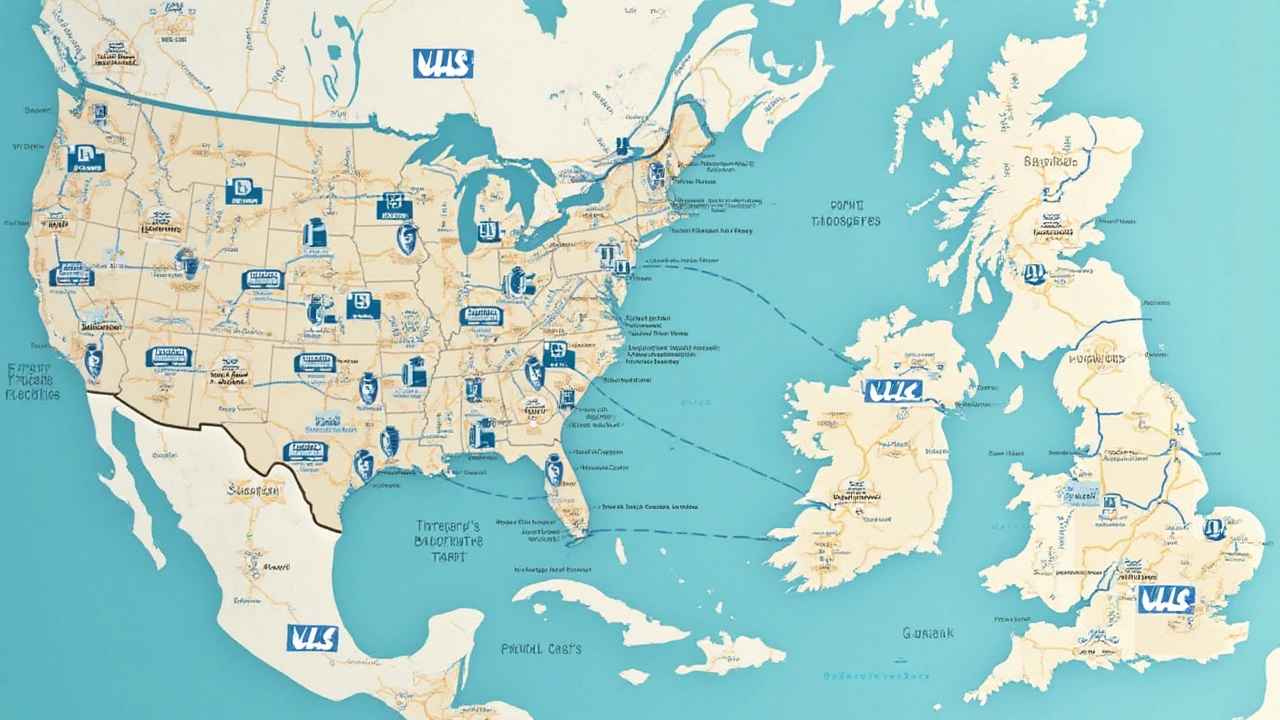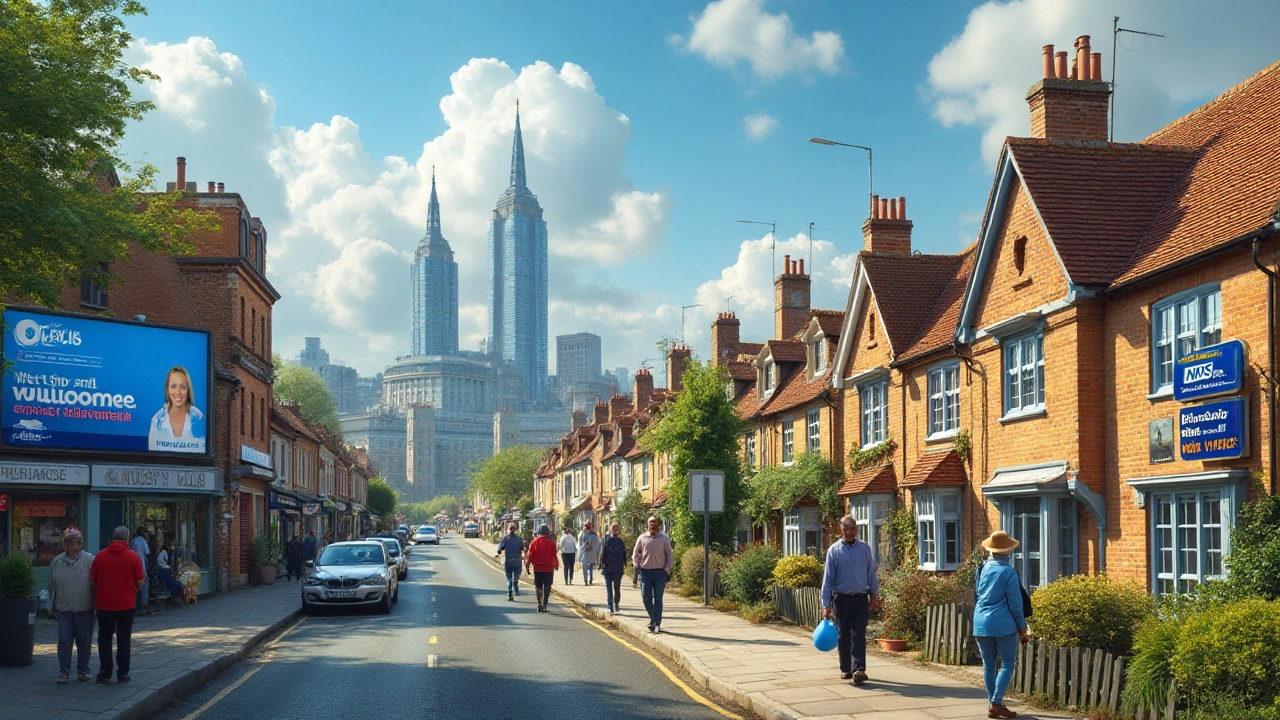Understanding the intricacies of healthcare systems is essential for those seeking clarity in a field that significantly impacts everyday life. Both the United States and the United Kingdom boast distinct approaches to healthcare delivery and insurance, each with its unique benefits and challenges. Whether you're a patient, a policymaker, or simply a curious observer, comprehending these differences can guide informed decisions.
In America, the landscape is dominated by a combination of private insurers and government programs, weaving a complex web that caters to diverse needs yet leaves gaps for some individuals. Meanwhile, across the Atlantic, the United Kingdom provides healthcare primarily through the National Health Service, offering universal access that is funded by taxpayers.
Let's embark on a journey to explore how these two powerhouses of healthcare structure, finance, and deliver services, shedding light on which system might align best with your values and expectations.
- Introduction to US and UK Healthcare Systems
- Funding and Structure
- Access to Services
- Quality and Outcomes
- Financial Implications for Patients
- Innovations and Future Considerations
Introduction to US and UK Healthcare Systems
The healthcare systems of the US and UK are often depicted as opposites, each representing distinct solutions to providing medical care to their populations. In America, the healthcare landscape is painted with a diverse palette of private insurance companies and government vouchers, creating a unique mosaic that combines both choice and complexity. Most individuals receive insurance through their employers, but a significant portion is covered by government programs like Medicare and Medicaid. Despite the abundance of options, this model often results in disparities in coverage, with access varying based on employment, income, and age.
Across the pond, the UK's healthcare system is characterized by the National Health Service (NHS), a publicly funded entity established in 1948. This system is unique in its foundational principle of providing healthcare access based on need rather than the ability to pay. Funded through taxation, the NHS offers comprehensive services from general practice visits to specialized treatments. While commendable in its universality, the NHS faces its own challenges, such as long wait times for certain treatments and resource constraints, which occasionally spark debates about its efficiency.
It's crucial to recognize that both systems strive to fulfill a fundamental right to healthcare, albeit through differing mechanisms. The US system emphasizes personalization and competition, offering patients the freedom to choose their providers and plans. Meanwhile, the UK strives for equality, ensuring everyone can access essential services irrespective of their financial status.
"The ultimate goal of any healthcare system should be to increase the value delivered by healthcare to patients and society." —Michael Porter, Professor at Harvard Business SchoolThese fundamental differences shape not only how care is delivered but also the experiences of those navigating these systems daily.
To provide a clearer picture, consider the ways technology and innovation play roles in each system. In the US, cutting-edge treatments and high-tech solutions are more readily available, driven by incentives for providers to adopt new technologies to compete. In contrast, while the NHS also values innovation, its adoption pace is moderated by the need to allocate resources judiciously across the entire population. Each system's strengths and weaknesses offer critical insights into how healthcare can be made more effective and equitable around the globe.
Funding and Structure
The way healthcare systems are funded and structured can paint a vivid picture of how they operate and serve the population. In the United States, the healthcare system is a mosaic of public and private entities. One of the most significant elements is the reliance on private insurance companies, which work alongside government programs such as Medicare and Medicaid. Private insurance can be obtained through employers or purchased individually, offering varying degrees of coverage with different premiums, deductibles, and out-of-pocket expenses. Employer-provided insurance is often seen as a benefit, though it does tie employees to their jobs for fear of losing coverage, a reality that many Americans navigate with caution.
Government programs like Medicare, which caters to those aged 65 and older, and Medicaid, which assists low-income individuals and families, are pivotal in providing care for millions. These programs are funded through a complex interplay of federal and state funds, ensuring coverage for vulnerable populations. It's interesting to note that despite being state-run, Medicaid programs can vary significantly from state to state in terms of eligibility and services provided. Interestingly, the total healthcare expenditure in the US is among the highest in the world, yet access to care remains unequal due to the uninsured population who often face financial barriers.
The United Kingdom presents a different philosophy with its National Health Service (NHS), which stands as a publicly funded system providing universal healthcare access. Established in 1948, the NHS was built on the principle of healthcare being free at the point of use, appealing to a sense of shared responsibility among citizens through taxation. Over the years, the NHS has evolved into a symbol of pride for many Britons, encompassing primary care, hospital care, and specialist services. This funding model, based on tax revenue, allows for a more uniform provision of healthcare services, avoiding the disparities seen in more market-driven systems.
In an analysis comparing the two systems, the BBC highlighted,
The NHS's centralized funding mechanism allows for more equitable distribution of resources, reducing the financial burden on individuals. However, it can also lead to longer waiting times and strain on services during peak periods.Such contrasts signify the diverse paths nations take to achieve health equity and quality. The NHS is often lauded for its efficiency and cost-effectiveness, spending significantly less on administrative costs compared to its American counterpart.
A glance at the numbers reveals the differing priorities and efficiencies: while the US spends approximately 17% of its GDP on healthcare, the UK allocates about 10%, reflecting the minimization of profit-driven motives within the NHS. Yet, both systems face unique challenges; the US grapples with rising costs and accessibility, whereas the NHS must continuously innovate to cope with demand and funding constraints. As such, understanding the healthcare system in both nations requires not only a look at funding and structure but also a contemplation of broader societal values and expectations.

Access to Services
When comparing access to healthcare services between the United States and the United Kingdom, the contrasts are striking and reveal a lot about each country’s values and priorities. In the US, the approach is a mosaic of options heavily shaped by one’s insurance plan, if one is fortunate enough to have a plan at all. Access can vary significantly depending on the type of health insurance coverage one has, which influences which doctors you can see and what treatments are covered. Some people, even with insurance, find themselves paying substantial out-of-pocket costs that can dissuade them from seeking necessary care. This aspect often emphasizes the notion that in the United States, the ability to access services frequently correlates with one's financial means.
Conversely, in the United Kingdom, the National Health Service (NHS) ensures that everyone, irrespective of economic status, has access to a broad range of healthcare services. It’s a one-size-fits-all model that celebrates inclusivity; however, this can sometimes lead to challenges like long waiting times for certain procedures or specialists due to the sheer volume of people relying on the system. Despite these hurdles, many citizens appreciate the peace of mind of a system that promises care at minimal direct cost, a stark contrast to the United States' highly privatized system.
One of the glaring gaps in access comes in the form of specialized or outpatient care in the US. Many individuals delay or forego these services due to the complex nature of insurance plans or the financial burden associated with them. A study found that about 25% of Americans have delayed or skipped medical treatment due to cost concerns, a sobering statistic that shines a light on access disparities within the country. On the other hand, similar services under the NHS are covered, albeit potentially after dealing with waiting lists, which is a trade-off many in the UK are willing to accept.
The National Health Service stands as a beacon for those advocating public health accessibility, despite criticisms often focused on waiting times or resource scarcity. A 2022 report praised the NHS for its role in reducing health inequalities, underscoring its mission to provide universal access to quality health services. One NHS patient remarked,
"Knowing that I can access healthcare without worrying about the cost allows me to focus on recovery and staying healthy."This sentiment captures the essence of what many appreciate in a system where the right to health is enshrined not by wealth but by birthright.
It is important to note that while Americans have the option to purchase more comprehensive or faster service through private means, the fundamental flaw remains that people without adequate insurance face significant barriers to services. Meanwhile, in the UK, discussions regarding improving the efficiency and capacity of the NHS are ongoing, with trends pointing toward increased funding and reforms aimed at reducing wait times and expanding staff. Both nations are continually evolving, seeking ways to balance accessibility, affordability, and quality in providing health services to their populations.
As healthcare systems worldwide face pressures from aging populations and emerging health challenges, the experiences of the US and UK offer insights that could potentially inform future improvements. For those navigating these systems, understanding where and how to access care can be as crucial as the care itself. Whether it is through private insurers or public health programs, ensuring comprehensive access to healthcare services remains a fundamental goal on both sides of the Atlantic.
Quality and Outcomes
When evaluating the quality of a healthcare system, one must consider a labyrinth of factors from patient satisfaction to clinical outcomes. In the United States, the healthcare quality often reflects the country's technological advancements and innovation, boasting cutting-edge treatments and facilities that attract global attention. Advanced cancer treatments, organ transplants, and robotic surgeries are some of the highlights of American healthcare. However, the disparity in access remains a pivotal issue, influencing the consistency of outcomes across diverse demographic groups.
Conversely, the United Kingdom's National Health Service (NHS) takes pride in delivering comprehensive care that extends to every resident. With its focus on equitable access, the NHS rates highly on preventive measures and primary care management. Outcomes such as life expectancy and reduced mortality from preventable diseases reflect the effectiveness of this approach. Nonetheless, the NHS faces challenges such as long waiting times for certain treatments, which can impact patient outcomes, especially for elective surgeries.
Statistics often serve as invaluable tools in this analysis. In 2023, according to the Commonwealth Fund, the UK's healthcare system ranked as more efficient compared to the US. They cried out the NHS's ability to provide cost-effective healthcare to its populace and emphasized the improvements in chronic disease management. A critical takeaway from their findings is the importance of consistent preventive care, which impacts both nations differently.
Let us consider expert opinions that add depth to this discussion. British healthcare professionals frequently highlight the 'proactive' nature of the NHS, which emphasizes regular check-ups and immunizations. As Doctor Sarah Johnson commented in a BBC health interview, the NHS's preventive strategies aim "not just to treat but to keep the population healthy from the outset." Yet, in the US, specialists often point to the rapid response and flexibility of the system; the private sector's competitiveness can drive excellence in specialty care areas. A Harvard Health report stated, "While challenges exist, the US healthcare market showcases groundbreaking medical research and innovation that save countless lives annually."
Moreover, patient-reported outcomes provide a personal glimpse into the efficacy of these systems. Many UK citizens express gratitude for the NHS, noting the peace of mind that comes with knowing they will be cared for without hefty medical bills. In contrast, Americans often mention a desire for a more simplified experience without the extensive paperwork involved with insurance claims.
Understanding these nuances is crucial. While both systems excel in certain areas, a blend of US innovation with the UK's comprehensive coverage might paint the picture of an ideal healthcare system. Reviewing these differences through the lens of insurance coverage sheds more light on the tangible impacts on everyday lives.

Financial Implications for Patients
When considering the healthcare system in the US, one of the immediate concerns for many patients is the cost burden. With healthcare pricing shrouded in obscurity, it's not unusual for individuals to face surprisingly high bills post-treatment. The root of this challenge lies in the predominance of private insurance plans, each with varying levels of coverage, premiums, and deductibles that can drastically influence an individual’s out-of-pocket expenses. A significant number of Americans find themselves juggling between purchasing expensive plans or risking higher financial exposure with minimal coverage options. This delicate balancing act often results in the unwelcome scenario where those least able to afford healthcare end up paying the most.
On the other side of the pond, the UK’s National Health Service (NHS) offers healthcare that's virtually free at the point of service due to its funding model, based predominantly on taxes. This setup ensures that financial considerations are minimized when accessing routine or emergency care, significantly reducing the anxiety associated with unforeseen medical expenses. Unlike the American system, surprise bills are nearly non-existent, as the costs are predominantly covered by the NHS. It should be noted, however, that while the NHS takes pride in providing equitable access, there are still minor costs associated, such as prescription charges, although these are capped at relatively low amounts.
Insurance Variability
In the United States, the variability in insurance coverage and cost remains one of the largest hurdles. An individual's employer, geographic location, and even the current legislative landscape can heavily influence their available options. For those without employer-backed insurance, navigating the Health Insurance Marketplace can be daunting, with over 11 million users as of recent enrollment periods. It's a system that demands detailed understanding and attentive management to ensure one's medical costs remain within a sustainable budget. Contrary to this, in the UK, the presence of private insurance plays a supplementary role, often being utilized for access to private healthcare facilities and reduced wait times rather than essential coverage.
"Approximately 45% of U.S. adults aged 19 to 64 experienced financial strains due to medical bills in 2022," according to a report by the Commonwealth Fund.
In terms of financial implications, the risk of medical debt in the US is a significant concern, with many finding their finances upended by necessary treatments. The concept of medical bankruptcy is uniquely American, driven by the high cost of care and insufficient insurance coverage for many citizens. In contrast, residents of the UK rarely encounter such dire financial repercussions from healthcare needs, thanks to the NHS's structural underpinnings, which prevent health-related financial crises from escalating.
While both systems strive to provide healthcare coverage, their approaches diverge significantly in their financial impact on patients. For many living stateside, the US's emphasis on personal responsibility and choice in healthcare insurance encourages a proactive approach in selecting the right level of coverage, though often at a significant financial commitment. This contrasts sharply with the UK's collective model, which emphasizes fiscal predictability and universal access, ensuring healthcare is treated as a communal priority.
Innovations and Future Considerations
The future of healthcare system efficiencies hinges largely on innovative technologies and transformative policies, both in the US and the UK. As technology advances, both countries continuously explore various avenues to improve healthcare delivery and patient outcomes. Artificial intelligence and machine learning are at the frontier, promising enhancements in diagnostics and personalized medicine. For instance, AI applications are already assisting in predicting patient deterioration and optimizing treatment plans, reducing human error and enhancing efficacy.
The UK’s NHS has been increasingly integrating digital health records, making it easier for different parts of the system to communicate and effectively manage patient data across various platforms. This interoperability of health data is seen as a significant step forward. In the US, telemedicine saw a sharp rise in adoption, especially during the pandemic, as patients and providers sought safe, contactless consultations. This trend is expected to continue with improved platforms and regulatory support. Notably, healthcare providers are experimenting with blockchain technology to secure patient data and create transparency in medical transactions.
In policy terms, the US is grappling with health equity, as innovations must address disparities in access due to varied insurance coverage. There's a strong push for policies that reduce bureaucratic bloat in the insurance process, tailoring services to meet diverse patient demographics. Meanwhile, the UK continues to battle funding challenges for the NHS. Discussions around sustainable finance models are crucial, as promising innovations may require significant investment.
"Technology can dismantle barriers in healthcare, offering unprecedented opportunities to broaden and deepen access," remarked a senior health scientist during a recent symposium.
Looking ahead, both healthcare systems are keen on biotechnological advances like genome editing and personalized therapeutics. These fields hold promise for treating conditions that are currently seen as untreatable or for which treatment options are limited. Breathtaking strides are being made in these areas that could redefine what we deem possible in medicine. The talented pool of researchers and clinicians in both the US and UK stand ready to surmount these challenges and seize opportunities on the medical and technological horizon, ensuring these innovations translate into quality care for all.
Catching the moment, several start-ups across both nations are pioneering in wearable technology, allowing continuous health monitoring remotely. This wave of wearables can track vital signs, alert emergency services in crises, and provide a real-time flow of data to healthcare professionals. In the US, several insurance companies have started offering benefits to users who participate in wellness programs reliant on such technology, aiming to incentivize healthy living while cutting costs in the long term. The trend towards such initiatives reflects a growing synergy between technology advancement and healthcare.
Statistics often tell a compelling story; a recent report showed a steady increase in patient satisfaction from telehealth services, rising by 40% over the last three years in the US. Similarly, UK reports indicate a 30% reduction in waiting times as a direct result of digital triage systems in hospital settings. Here's a glimpse into the digital transformation milestones recorded:
| Feature | US | UK |
|---|---|---|
| Telehealth Adoption | 85% | 70% |
| Digital Records Compliance by Hospitals | 65% | 90% |
Streaming ahead into the future, both countries must remain steadfast in their commitment to merge innovation with patient-centric care. Whether it's harnessing data analytics to predict outbreaks, or pushing the envelope in biotechnologies, the hermeneutics of healthcare continue to evolve. As these changes unfold, stakeholders at every level are actively engaged in shaping a healthcare landscape that aligns with the aspirations and necessities of our modern age.




